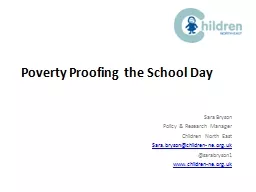

Sara Bryson Policy amp Research Manager Children North East Sarabrysonchildrenneorguk sarabryson1 wwwchildrenneorguk What do we mean by child poverty Government defines a household as being in poverty if ID: 638511
Download Presentation The PPT/PDF document "Poverty Proofing the School Day" is the property of its rightful owner. Permission is granted to download and print the materials on this web site for personal, non-commercial use only, and to display it on your personal computer provided you do not modify the materials and that you retain all copyright notices contained in the materials. By downloading content from our website, you accept the terms of this agreement.
Slide1
Poverty Proofing the School Day
Sara BrysonPolicy & Research ManagerChildren North EastSara.bryson@children-ne.org.uk@sarabryson1www.children-ne.org.uk Slide2
What do we mean by
‘child poverty’?Government defines a household as being in poverty if:
“its
equivalised
net income for the financial year is less than 60% of median equivalised net household income for the financial year”Peter Townsend provided an alternative definition which is:“Individuals, families and groups in the population can be said to be in poverty when they lack the resources to obtain the types of diet, participate in the activities, and have the living conditions and amenities which are customary, or at least widely encouraged or approved, in the societies to which they belong. Their resources are so seriously below those commanded by the average individual or family that they are, in effect, excluded from ordinary patterns, customs and activities” (Townsend, 1979)Slide3
Why Poverty Proof the school day?Slide4Slide5
‘Look there’s Hope, She’s got holes in her shoes,
Pays nothing for dinners,And holds up the queue’s,Going home with a face full of sorrow,But don’t worry Hope,We’ll get you tomorrow’Slide6
ChallengesIFS predictions 2020 4.7m children in povertyIn work poverty 66%Hunger
& Food PovertyLow pay, no pay economyPerfect Storm –Increase in needs, decline in support servicesSlide7
Children’s Commission on Poverty:Cost of the School Day Inquiry
http://childrenscommission.org.uk/report-70% of parents say they have struggled with the cost of school. This rises to 95% of parents Who live in families that are ‘not well off at all’.-51% of parents said they had cutback on clothing, food or heating toafford school costs.
-25% of parents (and more
than half of those in families which
were ‘not well off at all’) said they hadborrowed money in order to afford thecost of school.Slide8
NASUWT
Cost of Education survey“The Union has been surveying parents for the last two years and there is no doubt that they are facing increasing costs in supporting their children’s education.The NASUWT has been warning that for many children access to critical educational opportunities, which are key entitlements, are increasingly becoming based on parents’ ability to pay.”Slide9
Poverty & Shame
‘Schools broadened horizons but the stark differences it exposed were a source of shaming: smartly dressed or not, more than one set of uniform or not, hungry or not, pocket money or not, calculator or not, the list was endless’
Walker
et al
(2013)Slide10
‘children identify free school meals as a very specific and visible difference, which clearly leads to fears of them being labelled and bullied’
‘Several parents talked about their fears of their children being stigmatised, especially where they themselves had painful memories of receiving free school meals’Ridge (2002)Slide11Slide12
The Attainment GapSlide13Slide14
‘Remove the barriers to learning’ No activity and planned activity in schools should identify, exclude, treat differently or make assumptions about those children whose household income or resources are lower than others. Slide15
Do you know who is poor in your school?Slide16
Challenging Policy & Practice
Unintentional stigma & discriminationAbility sets & behaviour
Bullying
Exams and resources
Extra-Curricular activityFood and the administration of FSMGovernance & School LeadershipHomeworkResourcesTransportTutor GroupsUniformSlide17
What are we doing?Digital toolkit for schools
www.povertyproofing.co.uk Audit the school dayTeacher & Governor trainingSupport to implement an action planSupport to plan pupil premium spending and monitor impactQuality Assurance & Kite MarkNewcastle University EvaluationEarly Years DevelopmentSlide18
www.povertyproofing.co.uk Slide19
ImpactSlide20
Questions?
Sara BrysonPolicy & Research ManagerChildren North EastSara.bryson@children-ne.org.uk@sarabryson1
www.children-ne.org.uk
@
ChildrenNEwww.facebook.com/ChildrenNorthEast